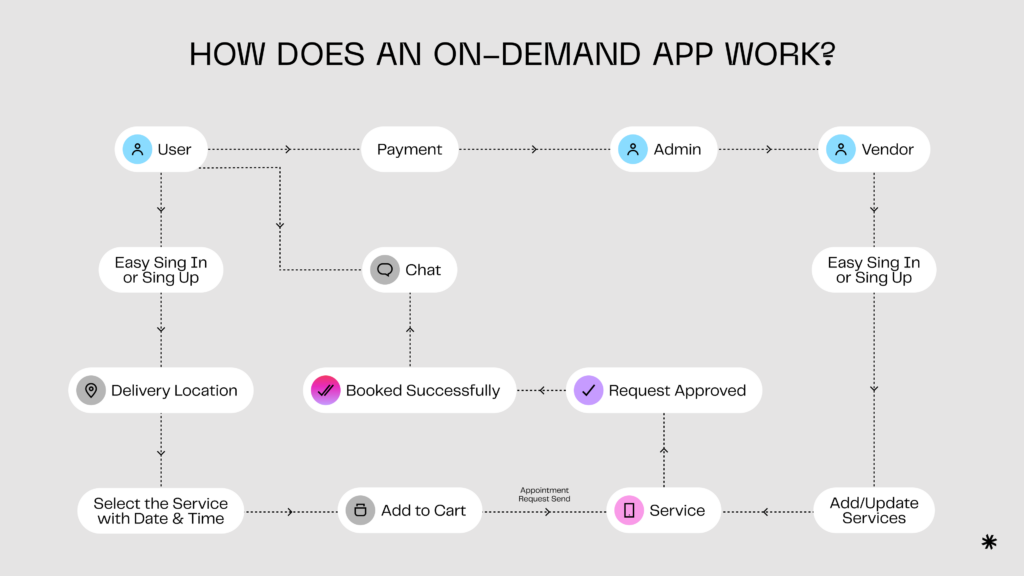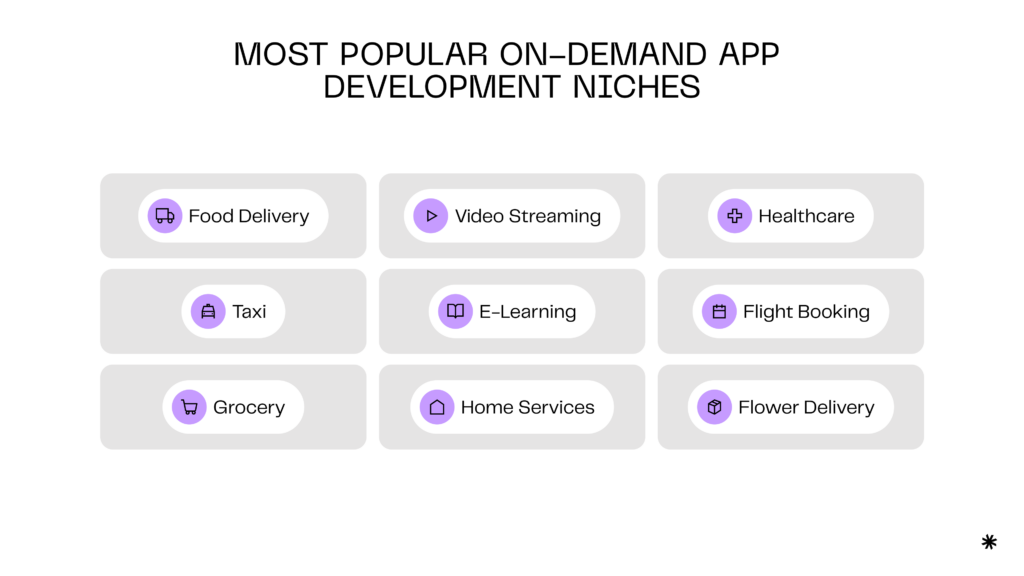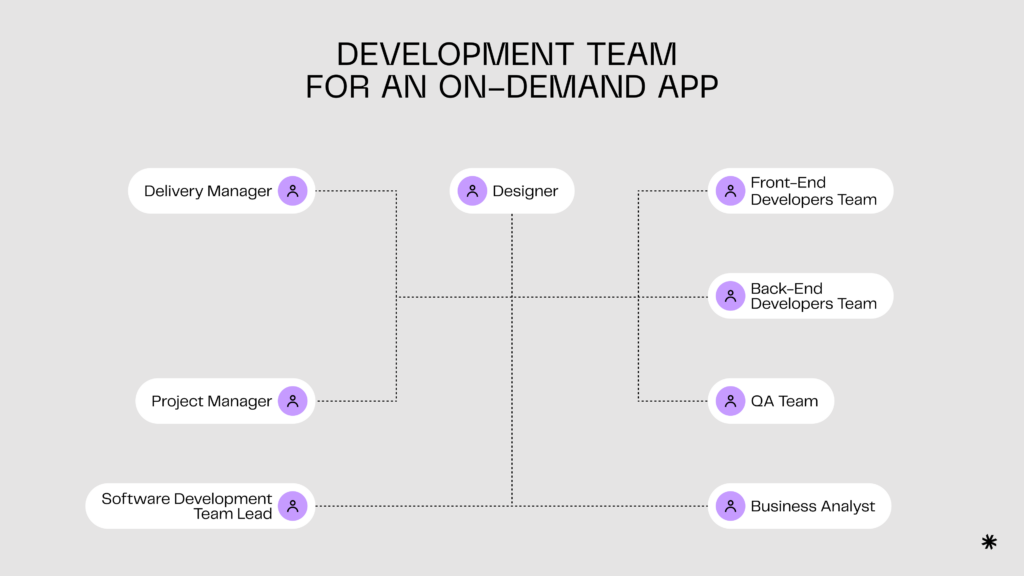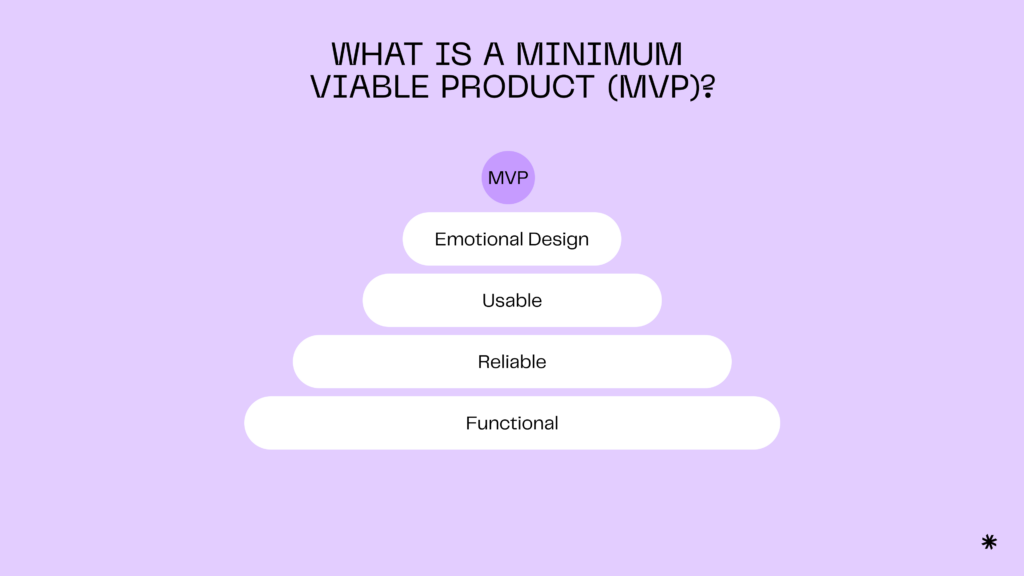Are you struggling to create an on-demand app that balances business goals, user satisfaction, and cutting-edge innovation—all while staying within budget?
This blog post is here to help. Whether you’re aiming to enhance customer acquisition, integrate advanced features like AI-driven recommendations, or ensure seamless scalability, we’ve got you covered. We’ll explore:
- What on-demand apps are and why they’re transformative;
- Key benefits, from automation to revenue growth;
- How to build an on-demand app step by step;
- Essential features for users, providers, and admins;
- Factors affecting development costs and budget planning.
With Syndicode’s expertise in mobile app development and custom software solutions, we can bring your vision to life and help you deliver an app that stands out. Let’s jump into it.
What is an on-demand app?

An on-demand app is a digital platform that connects users with the products or services they need instantly or within a scheduled timeframe.
Unlike traditional marketplaces with delayed delivery timelines, on-demand apps prioritize real-time service delivery, localized operations, and immediacy.
Examples of popular on-demand apps include Uber for ride-sharing, DoorDash for food delivery, Instacart for grocery shopping, and Fiverr for freelance services.
Each caters to specific needs, providing seamless user experiences with features like real-time tracking, secure payments, and user reviews.
Benefits of on-demand app development
On-demand apps enable businesses to reach customers beyond traditional operating hours, optimize workflows, and offer innovative features—helping them stay competitive in the evolving fashion and e-commerce landscape. Here’s how:
Increased revenue streams
On-demand apps effectively leverage revenue strategies like subscription models, premium features, and commissions, tailoring them to real-time services.
For a deeper dive into the business models used by mobile apps, check out our detailed blog post on how mobile apps make money.
As an example, consider an on-demand food delivery app, DoorDash, which increased revenue with its DashPass subscription. The company offers free delivery and reduced service fees, which have boosted customer loyalty and order frequency.
Combined with commissions from restaurants and delivery fees, this diversified model helped DoorDash dominate the U.S. food delivery market and generate billions annually.
Expanded market reach
On-demand apps make services accessible anytime, anywhere, reaching a global audience.
For example, Uber operates in over 70 countries, transforming how people access transportation. It provides instant, reliable rides at any time, revolutionizing urban mobility and exponentially expanding its customer base.
Process automation
On-demand apps streamline operations by automating tasks such as scheduling, inventory management, and notifications. This reduces manual effort, optimizes costs, and maintains consistent service quality.
DoorDash, for instance, uses automation to match couriers with orders, ensuring faster delivery and smoother operations.
Data-driven insights
On-demand apps leverage user behavior data to deliver real-time personalized experiences. This boosts engagement and ultimately drives increased company profits.
For instance, Uber Eats recommends meals based on past orders, enhancing customer satisfaction and driving repeat usage.
Competitive edge through innovation
On-demand apps are uniquely suited to adopting innovative features, keeping businesses ahead.
For example, Instacart leveraged real-time tracking and AI-driven personalization to revolutionize grocery shopping with same-day delivery and tailored product recommendations.
Workforce optimization
On-demand apps are integral to the gig economy, attracting skilled, flexible workers by offering clear schedules and competitive pay. This model benefits businesses by providing access to a scalable workforce, reducing overhead costs associated with full-time employment.
Take TaskRabbit, for example—it lets gig workers pick tasks that fit their skills and schedule. With clear pricing and instant payouts, it keeps workers motivated and makes gig work easier and more appealing.
Ready to build your on-demand app?
Partner with Syndicode to turn your vision into reality. With our expertise in on-demand mobile app development, we’ll help you create a seamless, scalable solution that stands out in today’s competitive market. Contact us today to get started!
Contact usTypes of on-demand delivery business models
The world of on-demand apps is incredibly diverse, catering to countless industries and needs. When planning how to build an on-demand app, it’s helpful to focus on two primary classifications: platform-centric models and delivery-centric models. Then, we’ll take a brief look at hybrid models that combine the strengths of both.
Platform-centric models
Platform-centric apps serve as intermediaries, linking users with service providers or sellers without owning the services or products themselves. Instead, they facilitate transactions and provide a seamless platform for interaction.
For instance, apps like Airbnb connect travelers with property owners, and Fiverr links clients with freelancers. Success in this model relies on creating a robust, user-friendly platform that benefits both sides.
To generate revenue, these apps often rely on models such as charging transaction fees, offering advertising opportunities, or providing premium features through subscription plans.
Delivery-centric models
Delivery-centric apps focus on efficiently moving goods or services to customers. These apps often manage logistics and operational aspects to ensure timely delivery.
DoorDash exemplifies this model by connecting restaurants with customers and handling delivery operations. Similarly, Instacart coordinates with local stores to ensure same-day grocery delivery.
Delivery-centric businesses often charge flat-rate or distance-based delivery fees, apply percentage-based fees to orders, or offer subscription-based benefits such as free deliveries or reduced service charges.
Hybrid models
Hybrid apps blend elements of both models. For example, Uber acts as a platform connecting drivers with riders but also incorporates delivery services through Uber Eats, offering greater flexibility and revenue diversification.
Businesses using a hybrid model often implement dynamic pricing, adjusting costs based on demand to maximize revenue. They may also provide bundle packages, combining multiple features or services into a unified offering for added value.
Additionally, some hybrid-model businesses generate income through white-label solutions, licensing their platform technology to other companies.
Essential features of an on-demand application
To succeed, an on-demand app must deliver value to three key stakeholders: users, service providers, and administrators. Each requires tailored features to ensure smooth functionality, excellent user experience, and efficient management.
Below, we’ll explore the essential features for each group.
| Category | Feature | Description |
|---|---|---|
| User-centric features | User registration and profiles | Allows users to sign up, manage personal details, and access services seamlessly, often with quick options like email or social media sign-up |
| Search | Enables users to quickly find services or products, with filters for types, prices, and delivery times | |
| Real-time tracking | Lets users track orders or services live, increasing trust | |
| Scheduling and booking | Allows users to book services in advance, such as scheduling home cleaning appointments on Handy | |
| Payment integration | Supports multiple secure payment methods like cards, digital wallets, and in-app payments | |
| Push notifications | Keeps users informed about updates, promotions, or order statuses | |
| Ratings & reviews | Encourages user feedback to improve service quality and highlight top freelancers | |
| Customer support | Provides real-time issue resolution via chat, email, or calls | |
| Service provider features | Profile management tools | Allows providers to update details like availability and skills, as seen in TaskRabbit where workers set rates and expertise |
| Order management | Helps manage incoming requests and service statuses, like Uber notifying drivers of ride requests and tracking completion | |
| Analytics | Offers insights into performance metrics, such as earnings and customer feedback | |
| Push notifications | Alert providers to new opportunities or schedule changes | |
| Admin panel features | User and provider management | Enables admins to monitor and manage participants, such as verifying hosts and resolving disputes on Airbnb |
| Order tracking | Provides oversight of service or product delivery statuses | |
| App analytics | Offers detailed insights into platform performance to refine strategies | |
| Dispute resolution | Facilitates complaint resolution between users and providers, as seen in Fiverr’s mediation system | |
| Promotions and marketing management | Lets admins run targeted campaigns and discounts to drive engagement |
Not sure which features to choose?
At Syndicode, we guide you in choosing and implementing the most impactful features for your business needs. Contact us to create a user-friendly, scalable app tailored to your goals!
Write to usHow to build an on-demand app?
Building a thriving on-demand app requires a well-structured approach to ensure it meets market demands while remaining scalable and user-friendly.
Below are the key steps to follow for an effective on-demand app development process.
Step 1. Do the research and choose your niche
The foundation of a successful app lies in understanding exactly what problem your app solves and how it does it. To shape your idea effectively, research the following:
- Target audience, including their age, location, occupation, income, and preferences;
- Pain points – the specific issue(s) your app aims to solve. Try to also understand how these challenges impact your target audience’s daily life or business operations;
- User behaviors: learn what apps your target users currently use and how they interact with those solutions;
- Competitors, including identifying key players in your industry and studying their strengths and weaknesses;
- Revenue models your competitors use and identify potential gaps to explore new revenue opportunities;
- Market trends and emerging technologies relevant to your business, such as AI or blockchain. Consider common user preferences in your industry, such as personalization, speed, or sustainability.
This research helps you position your app within the broader industry landscape, ultimately guiding you to define your niche. Choosing a niche is essential as it enables you to differentiate your mobile application with unique features tailored to specific demands.
It also allows you to focus your efforts and budget on strategies that truly resonate with your target audience.
For example, an on-demand app for pet care services targets pet owners specifically, offering features like scheduling vet appointments or booking pet sitters, which general on-demand apps may not provide. This specificity builds loyalty and ensures a stronger foothold in the market.

Get end-to-end development services with Syndicode!
Schedule your free first consultation and discover how we can help with everything from market research to post-launch maintenance. Let’s create a scalable, successful app tailored to your business goals!
Book a callStep 2. Choose the right technology stack
The technology stack heavily influences your app’s performance, scalability, and user experience. If you’d like a deeper dive, we have a detailed guide on selecting the right tech stack for various software projects. For now, let’s focus on the essentials.
Back-end technologies
The back end serves as the backbone of your app, managing data, business logic, and server operations. It handles user requests, processes transactions, and ensures seamless communication between app components.
Popular choices for back-end development include Ruby on Rails, Node.js, and Django, thanks to their speed, flexibility, and scalability.
Front-end technologies
The front end is the user-facing layer of your app, responsible for creating an intuitive and responsive user interface. It ensures a smooth and enjoyable experience for users.
Leading technologies for front-end development are React, Angular, and Vue.js, each offering unique advantages depending on the app’s complexity and design needs.
Mobile technologies
Mobile technologies are essential for delivering a seamless experience on both iOS and Android platforms. Tools like Swift, Kotlin, and React Native are widely used, offering options for native or cross-platform app development to ensure smooth performance across devices.
Databases
Databases store and organize all the app’s critical data, such as user profiles, transactions, and settings. The choice of a database depends on your data structure and app requirements.
Popular technologies for on-demand service app development include PostgreSQL for structured data, MongoDB for flexibility, and Firebase for real-time updates.
Emerging technologies
While not essential for basic functionality, cutting-edge tools like AI, Machine Learning, blockchain, and IoT can significantly expand your app’s capabilities. These technologies add a competitive edge, helping your app stand out in a crowded market.
| Category | Role | Popular technologies |
|---|---|---|
| Back-end Technologies | Manages data, business logic, and server operations; ensures seamless communication. | Ruby on Rails, Node.js, Django |
| Front-end Technologies | Creates an intuitive and responsive user interface; ensures a smooth user experience. | React, Angular, Vue.js |
| Mobile Technologies | Delivers a seamless experience on iOS and Android platforms; supports native and cross-platform apps. | Swift, Kotlin, React Native |
| Databases | Stores and organizes critical data such as user profiles, transactions, and settings. | PostgreSQL (structured data), MongoDB (flexibility), Firebase (real-time updates) |
| Emerging Technologies | Expands app capabilities with advanced features; adds a competitive edge in crowded markets. | AI, Machine Learning, Blockchain, IoT |
Step 3. Find an on-demand app development team

The right team is crucial for complex, long-term projects. While an in-house team offers control, it’s often cost-prohibitive for smaller businesses.
Partnering with an outsourced software development company like Syndicode provides access to experienced professionals, reducing costs while ensuring high-quality results.
Outsourcing saves time, enhances efficiency, and allows you to focus on core business activities. Look for a team with a proven track record, industry expertise, and a commitment to ongoing support.
At Syndicode, we specialize in developing scalable and feature-rich solutions for a variety of platforms, including iOS and Android devices, web applications, and cross-platform frameworks. From household services like HLPRS to employment platforms like Fuzu, we’ve helped businesses build innovative on-demand solutions tailored to their markets.
If you’re concerned about the risks of software outsourcing, we encourage you to explore our comprehensive guide to software outsourcing risks, which provides effective strategies to mitigate the most common challenges.
Step 4. Create an MVP version of your on-demand delivery app
Developing a Minimum Viable Product allows you to test your business idea quickly and cost-effectively.
An MVP focuses on delivering only the core features needed to gather feedback from early users. This invaluable feedback helps refine your app, ensuring it aligns with customer needs.
For instance, when Zomato, a food delivery app, first launched its MVP, it included features like a restaurant directory and advanced filters. However, they quickly learned that users prioritized quick delivery and order tracking over these extras.
This insight led Zomato to focus on real-time tracking and simplified ordering, boosting engagement and cementing its place in the food delivery market.

Step 5. Ensure QA and testing
For on-demand apps, where real-time functionality is critical, even minor glitches can result in customer dissatisfaction and churn.
That’s why quality assurance and testing are vital to ensure your app operates seamlessly. These processes help identify and resolve bugs, enhance performance, and maintain security and scalability.
Although QA is presented as a separate step in this guide, it’s actually a continuous process that begins during the discovery stage. QA encompasses various activities, with testing being a key component performed throughout the software testing lifecycle to ensure consistent quality at every stage.
Step 6. Launch the MVP and perfect your on-demand app idea
Once your MVP is live, the focus shifts to gathering feedback, monitoring performance, and analyzing user behavior.
Start by defining key performance indicators (KPIs) to evaluate your MVP’s success. While KPIs vary by project, the most common include:
- User engagement is measured through downloads, active users, and session durations, this reflects the level of user interest in your solution;
- Retention rates show how many users continue using the app over time, highlighting its long-term value;
- Feedback and ratings provide insights into what users like or dislike. Look for recurring praise or complaints to identify successful features and areas needing improvement;
- Revenue: The MVP phase is ideal for testing various monetization models to identify the most effective one.
Additionally, track app analytics to understand how users interact with features, guiding decisions for future development.
Once your app gains traction, user feedback validates the core functionality, and you see a clear path to monetization or scalability, it’s time to plan the next phase and enhance your app further.
How much does it cost to create an on-demand app?
The on-demand app development cost typically ranges from $50,000 to over $300,000, depending on various factors such as complexity and post-launch maintenance.
For a detailed breakdown, check out our comprehensive blog post on the cost of custom software development. Here, we’ll summarize the key factors.
App complexity and features
The more features your app has, the higher the cost. Basic apps with essential functionality (e.g., user profiles and payments) are more affordable, while complex apps with real-time tracking, AI recommendations, and advanced analytics require more time and resources.
Book your free consultation
Schedule a call with Syndicode to discuss your project and receive a custom quote tailored to your needs. Our experts are ready to guide you every step of the way. Let’s bring your app idea to life!
Schedule callPlatforms and mobile devices
Developing for a single platform (iOS or Android) is generally more cost-effective than building a cross-platform app. Frameworks like React Native can reduce costs by enabling simultaneous development for both platforms.
However, this approach still requires more resources compared to single-platform development.
Technology stack
The choice of programming languages, frameworks, and tools plays a critical role in on-demand app development cost, as it influences development speed and the availability of skilled on-demand app developers.
For instance, Ruby on Rails accelerates back-end development by leveraging pre-built modules. As discussed in our blog post, Why is Ruby Still Our Choice?, this significantly reduces both the development timeline and associated costs.
If your on-demand app involves AI software development, opting for a Python-compatible tech stack simplifies future integration.
Consider consulting a development expert to help you select a tech stack that strikes the ideal balance between cost and performance.
UI/UX Design
An intuitive, visually appealing design enhances user experience but can increase development costs. Custom designs with animations and detailed interfaces require more time and expertise compared to basic templates.
Development team location
Onshore teams—those located in your home country—provide advantages like direct communication and alignment with local business standards. However, if you’re based in the US or Western Europe, their rates are typically higher compared to teams elsewhere.
Offshore teams, such as those in Eastern Europe or Asia, are more cost-effective but may require extra effort to manage time zone differences and communication.
At Syndicode, we address this challenge by including a dedicated project manager in your team. This ensures seamless communication, transparent workflows, and regular progress updates, making collaboration smooth and efficient regardless of location.
Development timeframe
Longer development timelines naturally lead to higher costs. However, attempting to shorten the timeline excessively can result in even greater expenses, as it may require additional resources, overtime, or an accelerated workflow to meet the deadline.
To avoid these pitfalls, it’s crucial to set realistic deadlines that balance efficiency with quality, ensuring costs remain manageable while maintaining high development standards.
App maintenance and updates
Post-launch maintenance is an ongoing cost to ensure your app remains functional and competitive. This includes bug fixes, performance optimizations, and introducing new features as user demands evolve.
| Functionality | Description | Time estimates for an MVP | Time estimates for a fully-featured app |
|---|---|---|---|
| Project setup | Requirements definition, preparing tools, planning | Back-end – 32 h | Back-end – 32 h |
| User registration | Users should be able to sign in using the data from their social networks | Design – 8 h, Back-end – 8 h, Android/iOS – 32 h | Design – 12 h, Back-end – 12 h, Android/iOS – 40 h |
| Payment gateways | Enable users to choose the preferred way to pay for the service | Design – 12 h, Back-end – 12 h, Android/iOS – 64 h | Design – 16 h, Back-end – 16 h, Android/iOS – 120 h |
| Real-time tracking | Allows tracking the exact location of the courier | Design – 24 h, Back-end – 24 h, Android/iOS – 64 h | Design – 40 h, Back-end – 40 h, Android/iOS – 80 h |
| Total | 656 h | 936 h |
The key to a successful on-demand business? The right team behind it
Apps on demand are transforming industries by delivering convenience, efficiency, and innovation to both businesses and users.
Whether you’re starting with a simple MVP or aiming for a feature-rich platform, the potential for growth and customer engagement is immense.
At Syndicode, we’ve helped businesses across various industries create scalable, user-friendly on-demand solutions tailored to their unique needs. From market research to deployment and maintenance, our team provides end-to-end mobile development services to ensure your app’s success.
Ready to turn your app idea into reality? Contact Syndicode today to bring your vision to life with our expertise!
Frequently asked questions
-
What industries benefit the most from on-demand apps?
Industries that thrive on instant service delivery or seamless customer interaction benefit the most from on-demand apps. Key sectors include transportation (e.g., Uber), food delivery (e.g., DoorDash), healthcare (e.g., telemedicine platforms), retail and e-commerce (e.g., Instacart), and home services (e.g., Handy). These apps streamline operations, improve customer convenience, and enable businesses to reach a broader audience. Additionally, niches like fitness, entertainment, and logistics are increasingly adopting on-demand apps to cater to growing consumer demands for accessibility and speed.
-
How long does it take to build an on-demand service app?
The development timeline for an on-demand service application varies based on its complexity. A basic app with core features typically takes 3–6 months, while a more advanced app with functionalities like real-time tracking, AI integration, and analytics can require 6–12 months or more. For a more accurate estimate tailored to your project, it’s best to consult an experienced on-demand app development company. Keep in mind that factors like the team’s expertise, project scope, and chosen technology stack can impact the timeline, so estimates may vary slightly between providers.
-
How much does on demand app development cost?
The cost of making an on-demand app typically ranges from $50,000 to $300,000 or more, depending on factors like features, complexity, and platforms (iOS, Android, or both). Basic apps with essential functionalities fall on the lower end of the spectrum, while advanced apps with AI, blockchain, and custom designs drive costs higher. Other considerations, such as the development team’s location, chosen technology stack, and ongoing maintenance, also influence the budget. We highly recommend you partner with an experienced on-demand mobile app development company like Syndicode, as their expertise and resources can help you optimize costs while ensuring high-quality results.
-
How does an on-demand app work?
An on-demand app serves as a bridge between users and service providers or products, offering real-time convenience and efficiency. These apps typically allow users to create profiles, set preferences, and provide essential details for seamless transactions. With intuitive browsing features, users can easily search for goods or services, apply filters, and place orders. Integrated payment systems ensure smooth, cashless transactions. Modern on-demand apps rely on algorithmic matching to connect users with the nearest or most suitable providers, ensuring quick and accurate service delivery. They also have real-time tracking and update features to keep users informed about the progress of their orders, enhancing transparency and reliability. Finally, many on-demand apps offer administrative features to empower app administrators to mediate disputes, monitor performance, and ensure the platform runs smoothly.
-
What is the business model of on-demand apps?
On-demand apps typically operate on models like commission-based (e.g., Uber, which takes a cut of each transaction), subscription-based (e.g., DashPass for DoorDash), or freemium (offering basic services for free and charging for premium features). Some apps also combine these models, monetizing through advertising or partnerships. The choice of model depends on the target audience, app functionality, and industry dynamics, ensuring sustainable revenue generation.
-
Why should I outsource custom on-demand app development?
Outsourcing on-demand application development offers access to experienced professionals without the overhead costs of building an in-house team. It’s cost-effective, especially when working with offshore teams, and allows you to focus on core business activities. Expert vendors like Syndicode bring specialized skills, proven workflows, and end-to-end on-demand app development services, from market research to maintenance. Outsourcing ensures faster development, scalability, and high-quality results, making it a smart choice for complex, resource-intensive projects.
